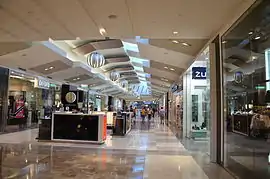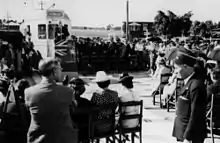Chermside, Queensland
Chermside is a major suburb of the City of Brisbane, Queensland, Australia.[4] The suburb is situated just 9 km north of the city and is one of Brisbane's fastest developing suburbs.[5] Chermside is known as a mini CBD of Brisbane.[6] It is home to the largest Westfield shopping centre in Australia.[7]
| Chermside Brisbane, Queensland | |||||||||||||||
|---|---|---|---|---|---|---|---|---|---|---|---|---|---|---|---|
 Chermside Shopping Centre | |||||||||||||||
| Population | 9,315 (2016 census)[1] | ||||||||||||||
| • Density | 2,740/km2 (7,100/sq mi) | ||||||||||||||
| Postcode(s) | 4032 | ||||||||||||||
| Area | 3.4 km2 (1.3 sq mi) | ||||||||||||||
| Location | 10 km (6 mi) N of Brisbane CBD | ||||||||||||||
| LGA(s) | City of Brisbane (Marchant Ward;[2] Northgate Ward)[3] | ||||||||||||||
| State electorate(s) | |||||||||||||||
| Federal Division(s) | Lilley | ||||||||||||||
| |||||||||||||||
Geography
Chermside is a key destination along Queensland Transport's future Northern Busway, and home to Westfield Chermside, the largest Westfield shopping centre in Australia,[8] with 3-story Myer and a 16 screen cinema complex. Together with Indooroopilly, in the west; Carindale, in the southeast; and Upper Mount Gravatt, on the south side; the suburb has been described as a mini-CBD.
Demographics
In the 2011 census, Chermside recorded a population of 8,170 people, 53.2% female and 46.8% male.
The median age of the Chermside population was 35 years of age, 2 years below the Australian median.
59.5% of people living in Chermside were born in Australia, compared to the national average of 69.8%; the next most common countries of birth were India 4%, New Zealand 3.8%, Philippines 2.7%, England 2.6%, China 1.5%.
67.9% of people spoke only English at home; the next most popular languages were 1.7% Malayalam,1.5% Tagalog, 1.3% Italian, 1.3% Mandarin, 0.9% Korean.
History
The Chermside area was first settled by Europeans in the late 19th century. The first plot of land was sold on 23 May 1866, and the population has progressively increased since with a significant increase with the post-war residential development.
When the Gympie goldrush started in 1867, many travellers heading north would run into trouble at a creek in present-day Chermside. Because of this waterway, Chermside was first known as Downfall Creek.[9] In November 1868 Cobb & Co. stagecoaches began to travel through the area on the way to the goldfields at Gympie.

Brisbane's tramway network finally reached the suburb on 29 March 1947, and Chermside remained the northernmost point on the system until the line to Chermside was closed on 2 December 1968. The tram line along Gympie Road was separated from other traffic (this is commonly called "reserved track"), which resulted in fast travel times along this portion of the route. Another feature of the Chermside tram line were the rose gardens which bordered the reserved track portion of the line.
The suburb's name was changed to Chermside in 1903 after the Governor of Queensland, Sir Herbert Chermside.[4]
Chermside State School (then called Downfall Creek State School) was opened on 9 July 1900 and closed on 13 December 1996.[10] Craigslea State School opened 24 January 1972 and the neighbouring Craiglea State High School in January 1975.[10]
The Dawn theatre first opened in 1928 (showing The Man Who Laughs), and closed on 2 August 2005 (with Mr. & Mrs. Smith). It was the last single screen cinema in Brisbane.

Westfield Chermside first opened in May 1957 as The Chermside Drive-in Shopping Centre with an Allan & Stark's department store and a small arcade of a dozen shops, before becoming a Myer department store. It was the first drive-in shopping centre in Australia. It is now the largest single level shopping centre in Australia, with a 3-storey Myer, as well as a 16-screen Birch, Carrol and Coyle megaplex. It is also home to Brisbane's first Apple Store.[11]
St Thomas' Anglican Church in Chermside East (now Wavell Heights) was dedicated on 13 October 1957 by Archbishhop Reginald Halse. Its closure on 21 December 1990 was approved by Assistant Bishop George Browning. It was deconsecrated was authorised by Archbishop Peter Hollingworth.[12]
St Laurence's Anglican Church in Chermside West was dedicated on 26 February 1966 by Archbishop Phillip Strong. It has since closed.[13]
The early 1970s saw the opening of Queensland's first Kmart store in Chermside, which was situated next to a Coles supermarket. Both of these stores closed in the mid-1990s and have been replaced with a Woolworths supermarket and specialty stores. Both Kmart and Coles have been relocated in Westfield Chermside.
Chermside has many outdoor recreational facilities, including two large parks, 7th Brigade Park, and Marchant Park - on land donated 9 September 1921 by soft drink manufacturer George Marchant. Before and during World War I this land had been variously the home of artillery and light horse units. During World War II a diverse range of volunteers, soldiers, and camps were at Chermside, such as U.S. Army units, including a number of African American soldiers. A Kitty Hawk airplane on a training flight crashed there in 1943, killing the pilot and instructor.
Chermside has had a library since 1909. Since 1951 it has been a branch of the Brisbane City Council Library service and had a major refurbishment in 2017.[14] The library is situated next to the Kedron Wavell RSL and some sports facilities, including a moderate water park. The Prince Charles Hospital (Public) was opened in 1959 and Holy Spirit Northside Private Hospital in 2001.
The Chermside State School was opened on 9 July 1900 but was closed on 13 December 1996.[15] A book about the school was written by Patrick O'Shea[16]
A history of Chermside was published by a local teacher and part-time historian Mr David R Teague in 1973.
The Hamilton family
One of the earliest settlers in Chermside was Andrew Hamilton who purchased acreage there in 1875. That land included today's Thomas Street.[9] Recently returned from the Gympie gold rush, Hamilton tried his hand at farming in Chermside. After failing as a farmer, Hamilton opened a successful blacksmith shop on Gympie Road which also served as the local post office. Hamilton's only son Thomas Andrew Hamilton became a councillor for Kedron Shire and was also a notable diarist.[9] T.A. Hamilton kept detailed daily diaries from 1890 until his death in 1951 at the age of 91. Most of the diaries survive and are being digitised and transcribed by the Chermside and District Historical Society.[17] Hamilton Road in Chermside is named after Andrew Hamilton.[9]
Amenities
The Brisbane City Council operates a public library at 375 Hamilton Road.[18]
Transport
The Northern Busway between the Royal Children's Hospital and Windsor was completed in August 2009, and an extra 3 km of busway between Windsor and Kedron opened in June 2012 with Airport Link and 2 new busway stations at Lutwyche and Kedron. Planning for the ultimate Northern Busway between Kedron and Bracken Ridge (including Chermside) is being revised with stages subject to funding and government priority.[19]
References
- Australian Bureau of Statistics (27 June 2017). "Chermside (State Suburb)". 2016 Census QuickStats. Retrieved 25 October 2013.

- "Marchant Ward". Brisbane City Council. Brisbane City Council. Retrieved 12 March 2017.
- "Northgate Ward". Brisbane City Council. Brisbane City Council. Retrieved 12 March 2017.
- "Chermside – suburb in City of Brisbane (entry 43062)". Queensland Place Names. Queensland Government. Retrieved 22 July 2017.
- "Chermside Emerging As One of Brisbane's Fastest Growing Suburbs". 3 August 2016. Retrieved 22 September 2017.
- "Mosaic targets growing demand in Chermside". Business News Australia. 13 July 2015. Archived from the original on 22 September 2017. Retrieved 22 September 2017.
- Tucker-Evans, Anooska (22 June 2017). "Largest Westfield shopping centre dining precinct to open at Chermside". The Courier-Mail. Retrieved 22 September 2017.
- Price, Amy (1 April 2017). "Chermside redevelopment opens to shoppers on Thursday". The Courier-Mail. Retrieved 9 June 2017.
- Brisbane's Rich History. : Savills Brisbane. 2014–2017. p. 8.CS1 maint: location (link)
- Queensland Family History Society (2010), Queensland schools past and present (Version 1.01 ed.), Queensland Family History Society, ISBN 978-1-921171-26-0
- "Archived copy". Archived from the original on 24 January 2010. Retrieved 4 January 2010.CS1 maint: archived copy as title (link)
- "Closed Anglican Churches". Anglican Church South Queensland. Archived from the original on 3 April 2019. Retrieved 29 June 2020.
- "Closed Anglican Churches". Anglican Church South Queensland. Archived from the original on 3 April 2019. Retrieved 29 June 2020.
- "Public Libraries Statistical Bulletin 2016-17" (PDF). Public Libraries Connect. State Library of Queensland. November 2017. Archived (PDF) from the original on 30 January 2018. Retrieved 30 January 2018.
- "Opening and closing dates of Queensland Schools". Queensland Government. Retrieved 18 April 2019.
- O'Shea, Patrick; O'Shea, P; Society, Chermside & District Historical (2005). Chermside State School 1900-1996 : a short history of Chermside State School no. 929. Chermside, Qld. : Chermside & Districts Historical Society. ISBN 0646453432.
- "Chermside and District Historical Society Inc".
- "Library opening hours and locations". Brisbane City Council. 3 January 2018. Archived from the original on 30 January 2018. Retrieved 30 January 2018.
- "Busways, Queensland Department of Transport and Main Roads".
External links
| Wikimedia Commons has media related to Chermside, Queensland. |
- Chermside and Districts Historical Society
- University of Queensland: Queensland Places: Chermside and Chermside West
- Queensland School opening and closing dates- C
- Chermside Suburb Information
- "Chermside". BRISbites. Brisbane City Council. Archived from the original on 20 July 2008. Retrieved 30 October 2013.
- "Chermside". Our Brisbane. Brisbane City Council. Archived from the original on 16 January 2008. Retrieved 30 October 2013.
- Chermside tram line photo, 1952